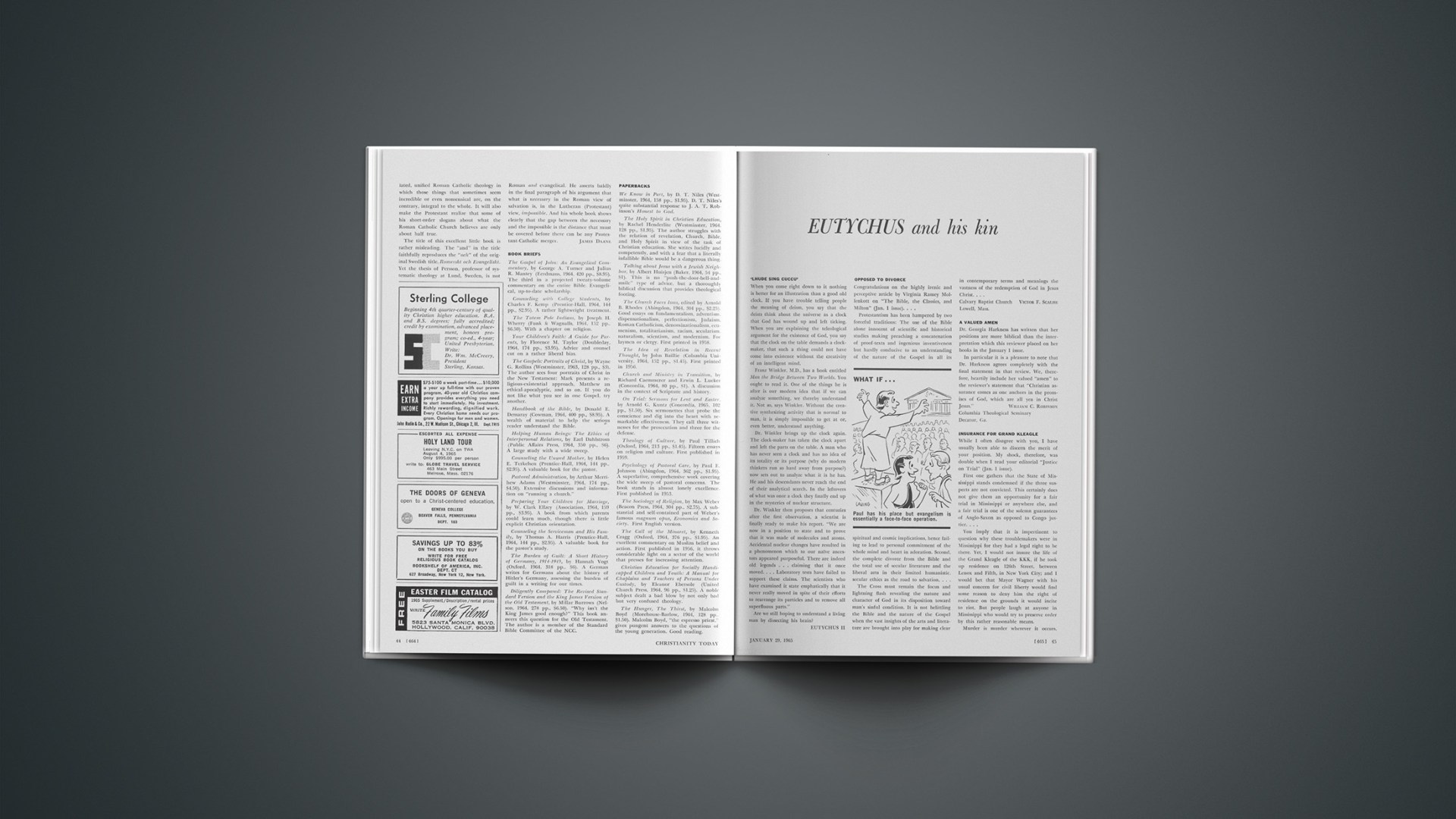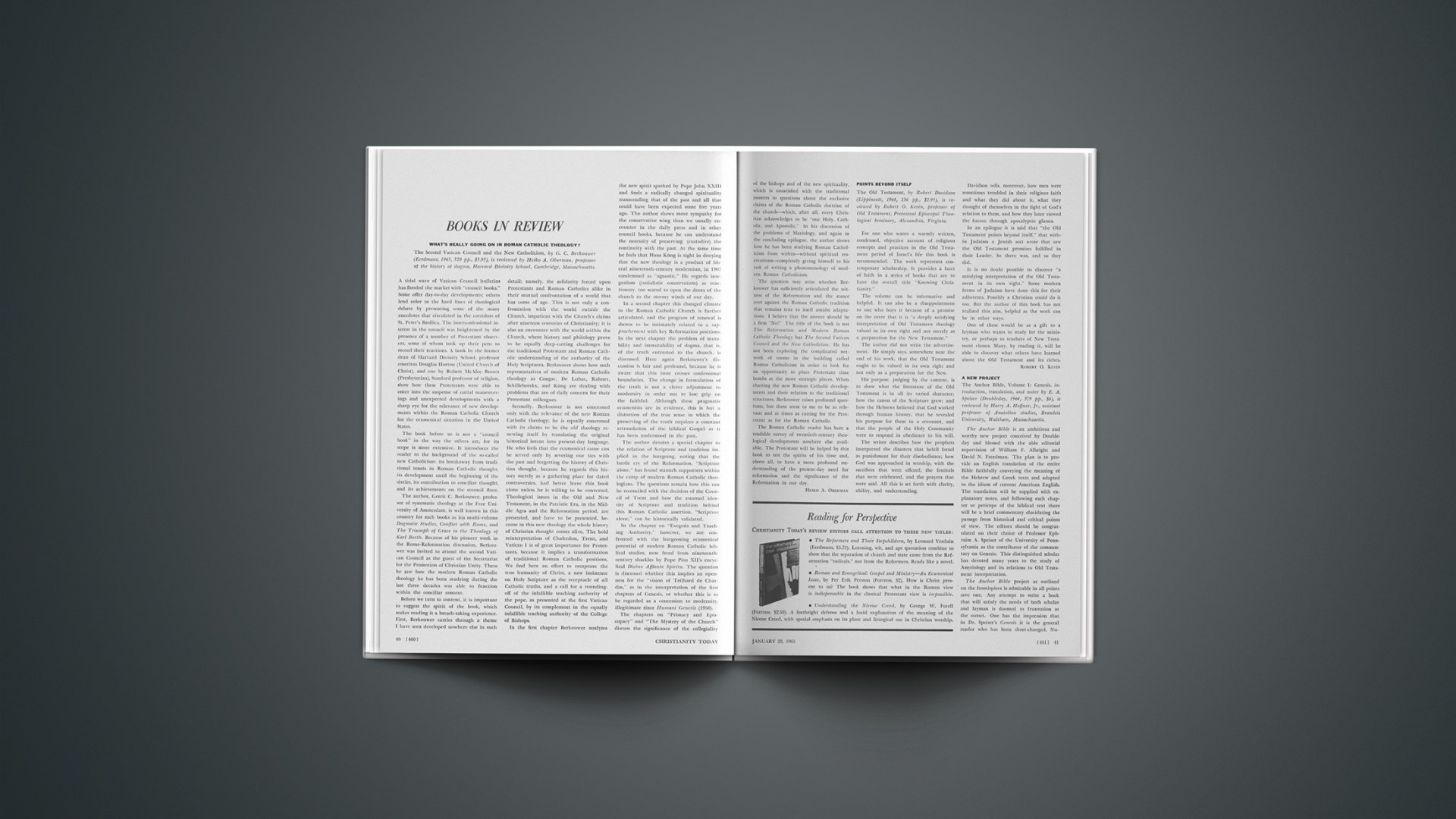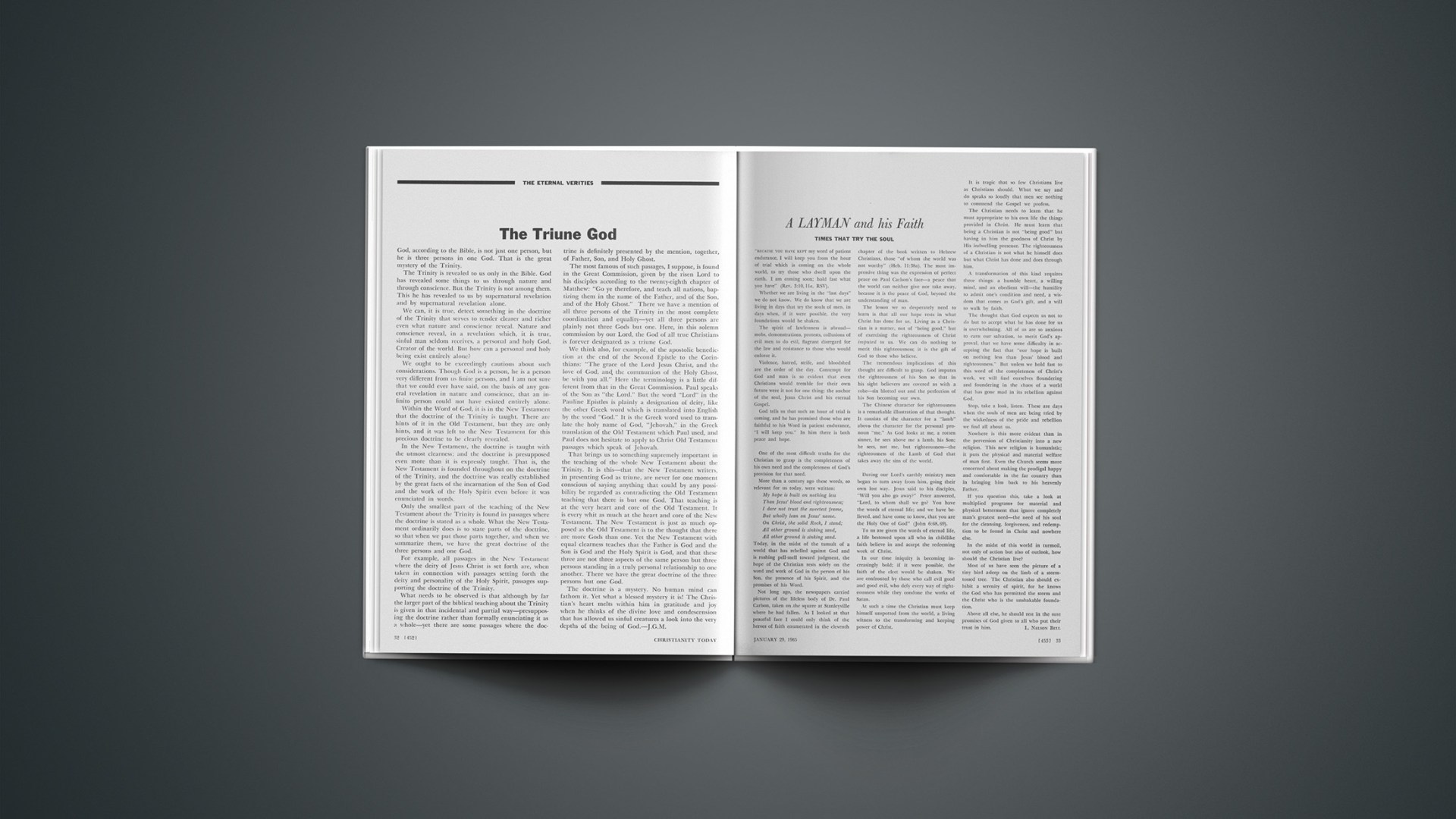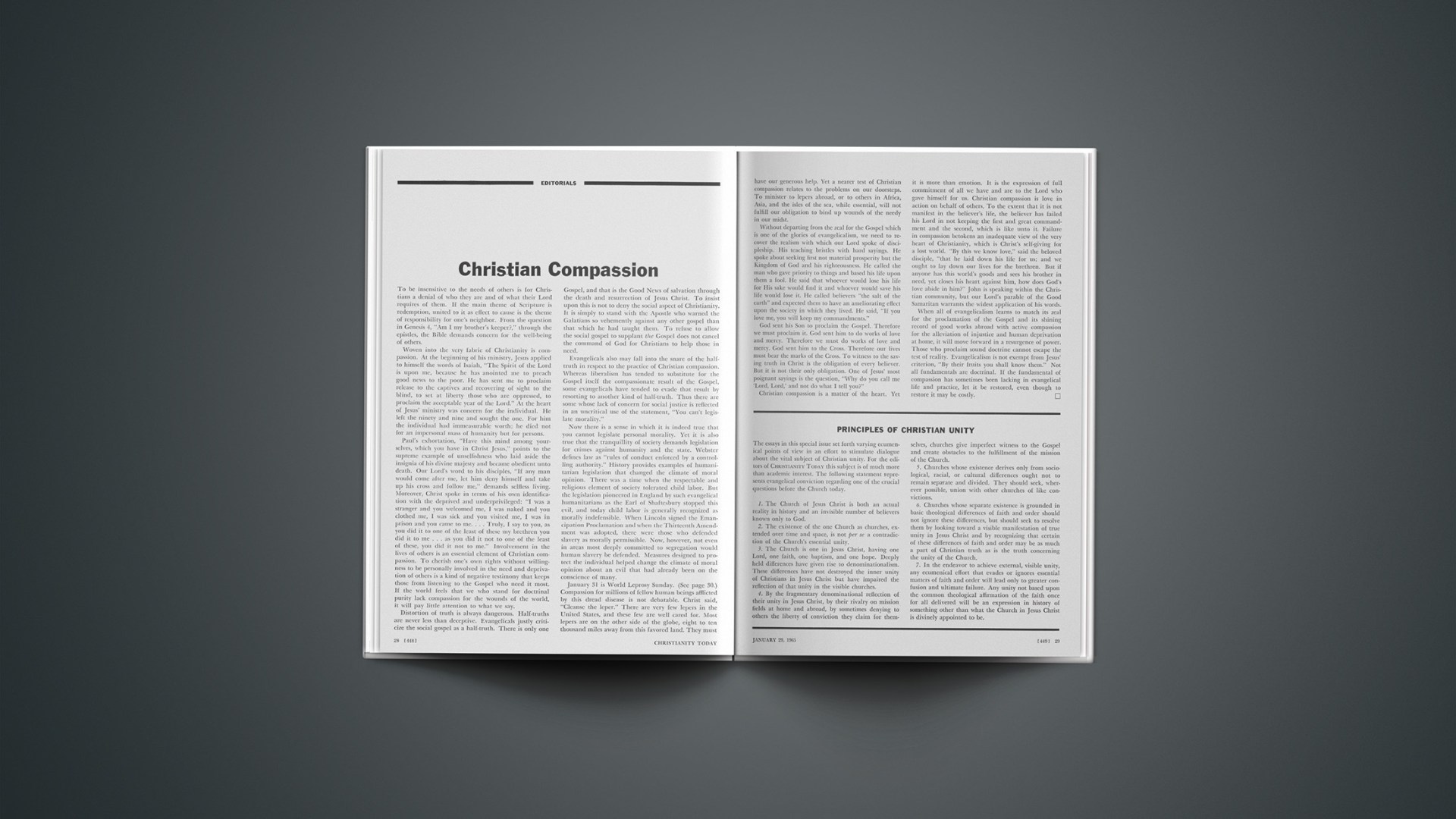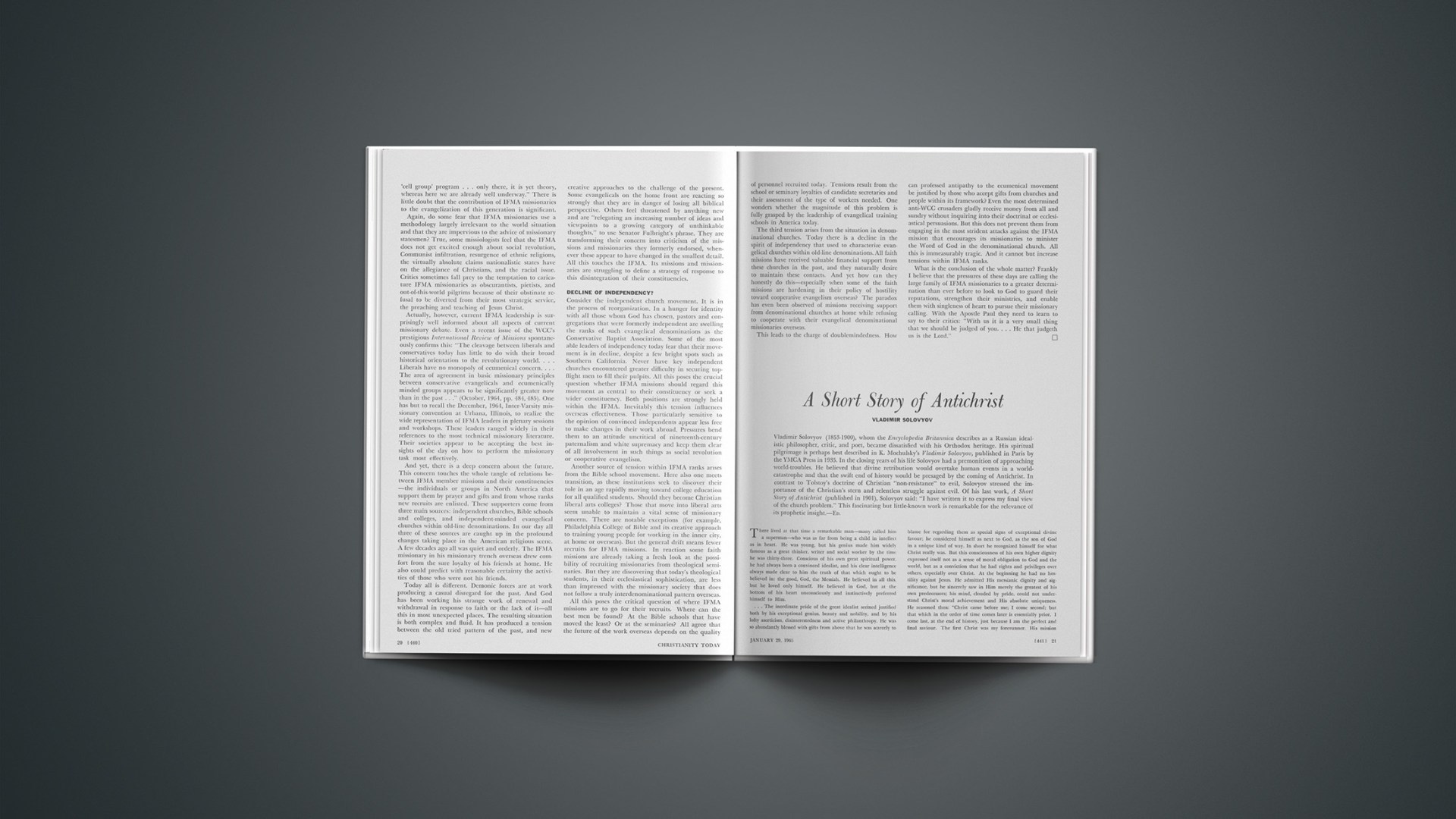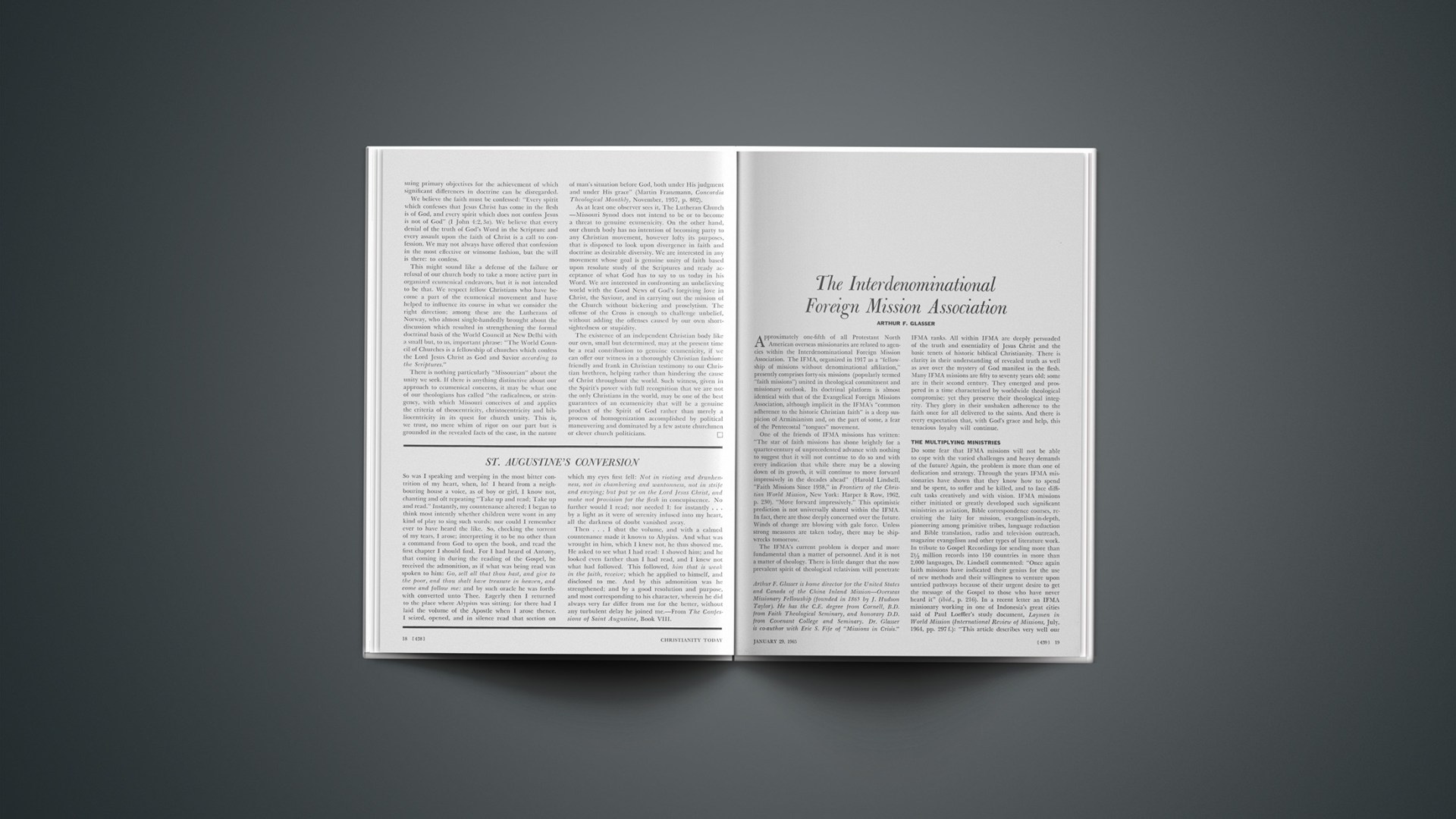‘LHUDE SING CUCCU’
When you come right down to it nothing is better for an illustration than a good old clock. If you have trouble telling people the meaning of deism, you say that the deists think about the universe as a clock that God has wound up and left ticking. When you are explaining the teleological argument for the existence of God, you say that the clock on the table demands a clock-maker, that such a thing could not have come into existence without the creativity of an intelligent mind.
Franz Winkler, M.D., has a book entitled Man the Bridge Between Two Worlds. You ought to read it. One of the things he is after is our modern idea that if we can analyze something, we thereby understand it. Not so, says Winkler. Without the creative synthesizing activity that is normal to man, it is simply impossible to get at or, even better, understand anything.
Dr. Winkler brings up the clock again. The clock-maker has taken the clock apart and left the parts on the table. A man who has never seen a clock and has no idea of its totality or its purpose (why do modern thinkers run so hard away from purpose?) now sets out to analyze what it is he has. He and his descendants never reach the end of their analytical search. In the leftovers of what was once a clock they finally end up in the mysteries of nuclear structure.
Dr. Winkler then proposes that centuries after the first observation, a scientist is finally ready to make his report. “We are now in a position to state and to prove that it was made of molecules and atoms. Accidental nuclear changes have resulted in a phenomenon which to our naive ancestors appeared purposeful. There are indeed old legends … claiming that it once moved.… Laboratory tests have failed to support these claims. The scientists who have examined it state emphatically that it never really moved in spite of their efforts to rearrange its particles and to remove all superfluous parts.”
Are we still hoping to understand a living man by dissecting his brain?
OPPOSED TO DIVORCE
Congratulations on the highly irenic and perceptive article by Virginia Ramey Mollenkott on “The Bible, the Classics, and Milton” (Jan. 1 issue).…
Protestantism has been hampered by two forceful traditions: The use of the Bible alone innocent of scientific and historical studies making preaching a concatenation of proof-texts and ingenious inventiveness but hardly conducive to an understanding of the nature of the Gospel in all its spiritual and cosmic implications, hence failing to lead to personal commitment of the whole mind and heart in adoration. Second, the complete divorce from the Bible and the total use of secular literature and the liberal arts in their limited humanistic, secular ethics as the road to salvation.…
The Cross must remain the focus and lightning flash revealing the nature and character of God in its disposition toward man’s sinful condition. It is not belittling the Bible and the nature of the Gospel when the vast insights of the arts and literature are brought into play for making clear in contemporary terms and meanings the vastness of the redemption of God in Jesus Christ.…
Calvary Baptist Church
Lowell, Mass.
A VALUED AMEN
Dr. Georgia Harkness has written that her positions are more biblical than the interpretation which this reviewer placed on her books in the January 1 issue.
In particular it is a pleasure to note that Dr. Harkness agrees completely with the final statement in that review. We, therefore, heartily include her valued “amen” to the reviewer’s statement that “Christian assurance comes as one anchors in the promises of God, which are all yea in Christ Jesus.”
Columbia Theological Seminary
Decatur, Ga.
INSURANCE FOR GRAND KLEAGLE
While I often disagree with you, I have usually been able to discern the merit of your position. My shock, therefore, was double when I read your editorial “Justice on Trial” (Jan. 1 issue).
First one gathers that the State of Mississippi stands condemned if the three suspects are not convicted. This certainly does not give them an opportunity for a fair trial in Mississippi or anywhere else, and a fair trial is one of the solemn guarantees of Anglo-Saxon as opposed to Congo justice.…
You imply that it is impertinent to question why these troublemakers were in Mississippi for they had a legal right to be there. Yet, I would not insure the life of the Grand Kleagle of the KKK, if he took up residence on 126th Street, between Lenox and Fifth, in New York City; and I would bet that Mayor Wagner with his usual concern for civil liberty would find some reason to deny him the right of residence on the grounds it would incite to riot. But people laugh at anyone in Mississippi who would try to preserve order by this rather reasonable means.
Murder is murder wherever it occurs, but I would be more inclined to want to bind your bleeding heart if you had had an editorial on the fact that King, “the most notorious liar in the United States,” his Communist pal Ruston, Abernathy, convicted of illegally distilling liquor, James Farmer, and the others, have not once uttered a word of condemnation of the murder and cannibalism by the rebels in the Congo while steadily condemning the Christian Tshombe. Apparently, these so-called Christian leaders of color do not find murder heinous when the victim is white. In the Congo no one is looking even for suspects. Have you joined the claque which constantly finds everything wrong with the United States, or the worriers about our world image? The world respects power and force, and that is the only image that the world appreciates, but this hardly concerns a religious magazine.
Finally we have Adam Clayton Powell convicted, and conviction sustained on every appeal, of violating the Ninth Commandment, the victim being a member of his own race. But he refuses to be punished by the fine of $46,000 and has used every dodge in the book. Don’t you think the State of New York stands condemned for refusing to sustain its own judiciary? Of course, there are those who say this is a fight among Negroes, so why be concerned. Being a Christian publication, I would assume you would not subscribe to this. But you haven’t said anything about it.
In the eyes of the Church, the Bride of Christ, all violations of any of the Ten Commandments are equally sinful be they murder, refusal to take care of aged parents, adultery, or bearing false witness against thy neighbor. A godless state may make distinctions perhaps, but what is that to thee? Follow Christ, who died for all men because somebody had to be convicted. The mob of religious leaders demanded it.
St. Peter’s Church (Episcopal)
Rosedale, N.Y.
POSSIBILITIES HERE?
After seeing that you allowed a book on speaking in tongues to be reviewed by Spiros Zodhiates (Jan. 1 issue), I will not be surprised if future books on democracy are reviewed by Mao Tse-tung or books on Luther by the Pope.
Philadelphia, Pa.
NO DOUBLE ENTRY SYSTEM
Praying for the dead is not contributing towards a double entry system of ecclesiastical bookkeeping (Eutychus, Dec. 4 issue) but an expression of the same Christian concern that prompts praying for others while still in this life.
It is said that during the Episcopal General Convention debate on the matter, an opponent delivered a somewhat flamboyant address by saying: “And when I’m dead, I shall be in the hands of God and won’t need anyone to pray for me.” He was followed by the evangelical James C. Foley, professor at the Philadelphia Divinity School, who said: “Brethren, I am in the hands of God already and I hope you still will pray for me!” The proposal carried, and prayers for the departed were restored to the American Prayer Book in 1928.
Prayers for the departed can be neither proved nor disproved by Scripture.…
Diocese of Albany
Albany, N. Y.
Bishop
WE LIKE THEM OVER HERE TOO
I enjoy J. Douglas’s reports on events on this side of the water as well as his contributions to Current Religious Thought.
May your magazine be more and more a shining and steady light in the confusion of religious thought in these days.… It is always thought-provoking, a bulwark for truth in this present age.
Edinburgh, Scotland
REFORMER, NOT DEFORMER
Quebec may be in transition (News, Dec. 18 issue), but Dr. John Mackay is 100 per cent right about the statue in front of Manrese, a Jesuit retreat house on Chemin Ste-Foy. It’s Martin Luther and no laughing matter in spite of the fact that “it’s regarded as a joke by both Protestants and Catholics” in Quebec.
Unless Jesuit thought is highly inconsistent, the figure at Manrese must be the Reformer and not the Deformer. Here in Rome the Jesuits have two statues that depict the same scene, and there is no doubt as to the identification of the figure being trodden under foot. The books that accompany the figures here in Rome have clearly written upon them the name MARTIN LUTERO.
The first statue is a gigantic work of art that towers approximately twenty-five feet in height. Although guidebooks of Rome in both English and Italian omit any reference to the existence of this masterpiece of anti-Protestantism, it is to be seen in a prominent alcove of the Church of Ignatius Loyola (Chiesa di Sant’lgnazio di Loyola).It depicts Loyola trampling Luther. A serpent entwines the “heretic’s” torso.
The other statue depicts the Virgin Mary flailing Martin Luther and John Calvin with a cat-o’-nine-tails. Again the figures are wrapped about by snakes, lying under the Virgin’s foot and holding their heads in torment.
Underneath the bodies are two books; one is engraved IOHANNES CALVINO, the other MARTIN LUTERO. TO the left of the Virgin is a little angel tearing the pages out of still a third book. The church sacristan tells that this is “the book of the Reformers,” and when I pressed him as to what book that was he replied: “The Bible, of course, what other book did the Reformers use?” This latter statue resides to the right of the altar under which Ignatius Loyola himself is buried in the mother church of the Jesuit order, La Chiesa di Gesu’(The Church of Jesus). Both these churches are in the heart of Rome.
Father Morisette may suggest that we view such statues “from the historical perspective of 300 years,” but it is still clear to any thinking Protestant that Vatican Council II has not yet produced the kind of atmosphere that would cause the church to destroy all such “false” imagery, just as she destroyed thousands of pagan statues and valuable works of art in Rome after the atmosphere had become “Christian” in the fourth and fifth centuries A.D.
If Rome really means business she will put all such statues in the dusty archives of some museum.
Italian Bible Institute
Rome, Italy
Director
JEWISH-CHRISTIAN RELATIONS
I was extremely pleased to read the article “The Jews and the Crucifixion” by George H. Stevens (Dec. 18 issue), and I felt that this may prove to be the most significant essay for the betterment of Jewish-Christian relations this year.
Minister in Charge
Los Angeles District Headquarters
American Board of Missions to the Jews
Hollywood, Calif.
LUTHER AND JAMES
Either Marianne H. Micks or Professor Mikolaski, following Micks, mistakes a fact in the professor’s book review (Dec. 4 issue).
Luther’s “strawy epistle” remark occurred in his preface to his 1522 edition of his German New Testament. My quotes are from Muhlenberg Press’s 1932 six-volume English version of selected writings of Luther, a translation made by several American Lutheran scholars. “In a word, St. John’s Gospel … St. Paul’s Epistles, especially Romans, Galatians … are the books that show you Christ.… Therefore St. James’ Epistle is really an epistle of straw, compared to them; for it has nothing of the nature of the Gospel about it”.…
Some modern Lutherans reconcile St. James with St. Paul’s doctrine of justification by faith alone, by putting a different interpretation on James than did Luther. New Castle, Ind.

